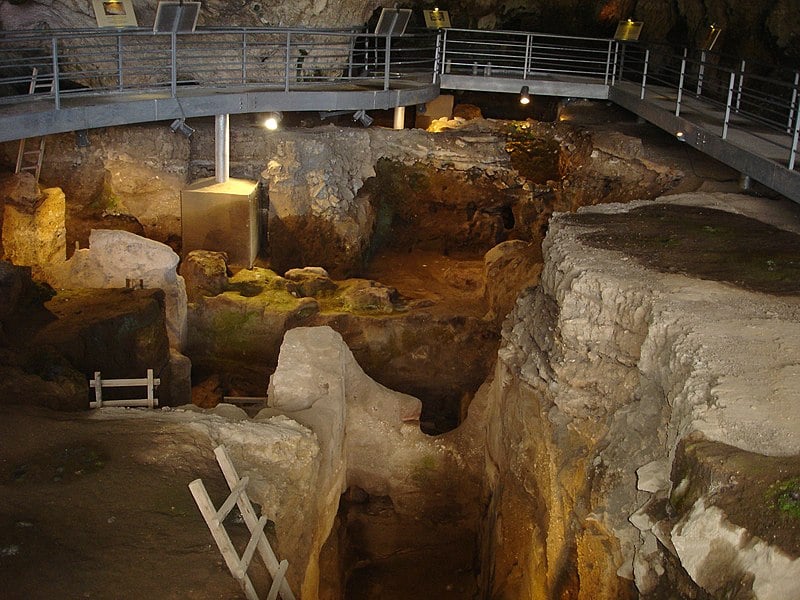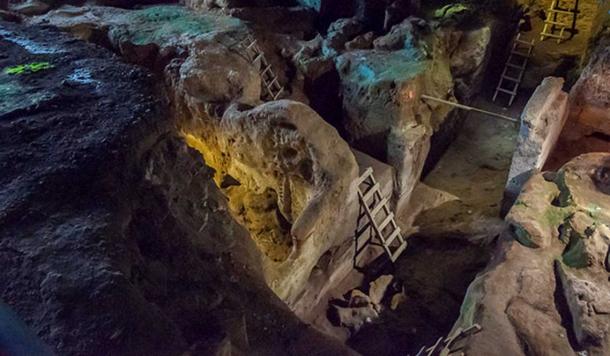The Theopetra Cave is an archeological site situated in Meteora, in the focal Greek area of Thessaly. Because of archeological unearthings that have been directed throughout the long term, it has been uncovered that the Theopetra Cave has been involved by people as soon as 130000 years prior. Likewise, proof for human residence in the Theopetra Cave can be followed without break from the Middle Paleolithic to the furthest limit of the Neolithic time frame. This is critical, as it permits archeologists to have a superior comprehension of the ancient time frame in Greece.
Theopetra Cave might be most seasoned man made structure
Theopetra Cave is situated at the foot of a 100-meter (330 foot) tall limestone precipice which looms over Theopetra town. The Lethaios River, a feeder of the Pineios River, streams close by.

Credit: Tolis-3kala /Wikimedia Commons/CC BY-SA 4.0
Geologists say that the limestone slope was framed somewhere in the range of 137 and 65 million years prior, during the Upper Cretaceous land time frame.
Grecian Delight upholds Greece
Archeological proof currently shows that people involved the cavern during the Middle Paleolithic time frame, around 130,000 years prior.
Theopetra cave has been depicted as being generally quadrilateral in shape, with little specialties on its outskirts. It covers an area of around 500 square meters (5,380 square feet). The cavern has an enormous entry, which permits a decent arrangement of light to go into the inside.

Excavations at the Theopetra cave began in 1987 under the direction of N. Kyparissi-Apostolika. ( CC BY-NC-ND 2.0 )
Archeologists have found a stone divider which once to some degree stopped the entry of the cavern.
Utilizing a moderately new strategy for dating known as “Optically Stimulated Luminescence,” researchers have now had the option to date this divider to around 23,000 years of age.
The age of the divider has driven scientists to accept that it had been worked by the cavern’s occupants to shield them from the virus. It has been guaranteed that this is the most seasoned known man-made structure in Greece, and potentially even on the planet.
Moreover, by directing micromorphological examination on sedimentary examples gathered from each archeological layer, researchers found that there had been hot and cold spells during the cavern’s occupation.
The cavern’s populace appeared to vary throughout the long term, comparative with these progressions in environment.
Further finds of the specialists were primate impressions engraved onto the cavern’s delicate earthen floor.
It has been hypothesized that these were made by a few Neanderthal kids, matured somewhere in the range of two and four years of age, who had hidden away far from anyone else during the Middle Paleolithic time frame.
By and large examination in Theopetra Cave has permitted archeologists to acquire a superior comprehension of the change from the Paleolithic to the Neolithic lifestyle in central area Greece.
An amusement of “Avgi,” the 7,000-year-old young lady found in the cavern
One of the main finds inside Theopetra Cave was the remaining parts of a 18-year-elderly person who lived in Greece 7,000 years prior.
Control of Theopetra Cave
The Theopetra Cave is arranged on the northeastern incline of a limestone slope, around 100 m (330 ft over a valley. The cavern disregards the little town of Theopetra, and the Lethaios River, a feeder of the Pineios River, streams close by. As indicated by geologists, the limestone slope was shaped somewhere in the range of 137 and 65 million years prior, which compares to the Upper Cretaceous time frame. In light of the archeological proof, individuals just started to possess the cavern during the Middle Paleolithic time frame, for example around 130000 years prior. The actual cavern has been portrayed as being generally quadrilateral in shape with little specialties on its outskirts and covers an area of around 500 sq meters (5380 sq ft). The Theopetra Cave has a huge entry, which permits light to enter bounteously into the inside of the cavern.

Excavations at the Theopetra cave began in 1987 under the direction of N. Kyparissi-Apostolika. ( CC BY-NC-ND 2.0 )
Examination Begins
The archeological exhuming of the Theopetra Cave started in 1987 and went on up until 2007. This task was coordinated by Dr. Nina Kyparissi-Apostolika, who filled in as the top of the Ephorate of Palaeoanthroplogy and Speleography when the unearthings were being completed. It could be referenced that when the archeological work were first led, the Theopetra Cave was being utilized by neighborhood shepherds as a transitory sanctuary in which they would keep their groups. It very well might be added that the Theopetra Cave was the principal cave in Thessaly to have been archeologically uncovered, and furthermore the only one in Greece to have a persistent succession of stores from the Middle Paleolithic to the furthest limit of the Neolithic time frame. This is huge, as it has permitted archeologists to acquire a superior comprehension of the progress from the Paleolithic to the Neolithic lifestyle in central area Greece.
A few fascinating revelations have been made through the archeological investigation of the Theopetra Cave. One of these, for example, relates to the environment in the space when the cavern was being involved. By leading micromorphological investigation on the dregs tests gathered from each archeological layer, archeologists had the option to verify that there had been hot and cold spells during the cavern’s occupation. Because of these progressions in the environment, the cavern’s populace likewise vacillated as needs be.
The World’s Oldest Wall
One more captivating find from the Theopetra Cave is the remaining parts of a stone divider that once to some degree shut off the entry of the cavern. These remaining parts were found in 2010, and utilizing a generally new technique for dating known as Optically Stimulated Luminescence, researchers had the option to date this divider to around 23000 years of age. The age of this divider, which harmonizes with the last chilly age, has driven analysts to propose that the divider had been worked by the occupants of the cavern to shield them from the cold outside. It has been guaranteed that this is the most seasoned known man-made structure in Greece, and potentially even on the planet.
A year prior to this unimaginable disclosure was made, it was declared that a path of somewhere around three primate impressions that were engraved onto the cavern’s delicate earthen floor had been uncovered. In light of the shape and size of the impressions, it has been hypothesized that they were made by a few Neanderthal youngsters, matured somewhere in the range of two and four years of age, who had hidden away far from anyone else during the Middle Paleolithic time frame.

In 2009, the Theopetra Cave was formally opened to people in general, however it was shut briefly a year after the fact, as the remaining parts of the stone divider were found in that year. Yet again albeit the archeological site was later re-opened, it was shut in 2016, and remains so because of security reasons, for example the gamble of avalanches happening
Unearthings, which have been efficiently done, have uncovered light topographical stores dating to the Pleistocene and Holocene periods as well as anthropogenic stores, showing that the cavern had been ceaselessly possessed during the Middle and Upper Paleolithic, the Mesolithic and the Neolithic time frames.
Examples found, like coal and human bones, demonstrate that the cavern was involved from around 135,000 BC to 4000 BC, and that brief utilize went on during the Bronze Age and memorable times up to 1955. Indeed, even after that the cavern was utilized incidentally to by shepherds to shield their groups’ until the unearthings started. Whenever cave first dwelling was kept in Thessaly during the Paleolithic time frame. The most recent cavern discoveries distributed in 2012 by the lead researcher and its group liable for the unearthings, Paleoanthropologist Dr. Ekaterini (Nina) Kyparissi-Apostolika, has raised the time records of cavern’s residence up to 135.000 BC.
Unearthings exposed three human impressions which have been dated to around 135,000 years prior. The track down comprises of four human impressions in succession, from four people accepted to have been youngsters matured 2 to 7. Those kids probably strolled on the remained cinders of a fire that later in time it became frozen and accordingly permitting impressions to be protected till present day.The stratigraphic succession of Theopetra cave stretches out through three cold periods: during the Middle time around 25,000 BC, during the Upper Paleolithic, and during the last Upper Paleolithic time frame (conclusion of the Pleistocene age).
The unearthings and investigation of the finds at Theopetra have been led beginning around 1987 by the logical exploration gathering of the branch of Paleoanthropology-Speleology, as we have previously referenced before under the course of Dr. Ekaterini (Nina) Kyparissi-Apostolika. Objects found in the cavern incorporate stone apparatuses of the Paleolithic, Mesolithic and Neolithic time frames, as well as Neolithic ceramics, bone and shell objects, skeletons from 15000, 9000 and 8000 BC, and hints of plants and seeds that uncover dietary propensities.

Excavations at the Theopetra cave began in 1987 under the direction of N. Kyparissi-Apostolika. ( CC BY-NC-ND 2.0 )
ImageBack in 2010 it was reported that as per an optical dating test known as Optically Stimulated Luminescence, that performed to date an as of late uncovered stall and applied on quartz grains settled inside the stones, it shockingly uncovered the most seasoned known man-made structure. The 23,000 year old stone divider before Theopetra cave likely worked to safeguard its inhabitants from cold breezes at the stature of the last ice age, is the most established known illustration of a man made structure!